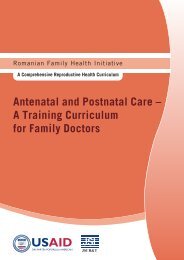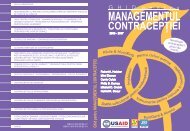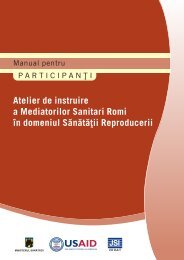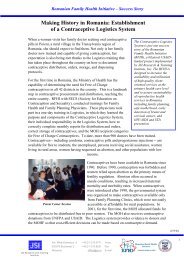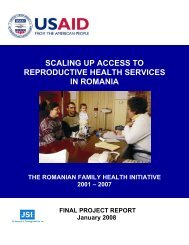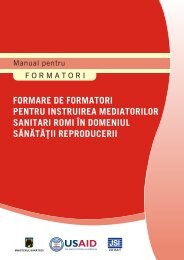Training of Roma Health Mediators in Reproductive Health
Training of Roma Health Mediators in Reproductive Health
Training of Roma Health Mediators in Reproductive Health
Create successful ePaper yourself
Turn your PDF publications into a flip-book with our unique Google optimized e-Paper software.
Tra<strong>in</strong>er document<br />
NATURAL FAMILY PLANNING METHODS (presentation)<br />
LACTATIONAL AMENORRHEA METHOD (LAM)<br />
LAM (Lactation = breastfeed<strong>in</strong>g. Amenorrhea = absence <strong>of</strong> menses. M=method) is a<br />
family plann<strong>in</strong>g method for breastfeed<strong>in</strong>g mothers which provides natural protection<br />
aga<strong>in</strong>st pregnancy for up to 6 months after birth.<br />
Mechanism <strong>of</strong> Action<br />
Lactational Amenorrhea Method can be used by breastfeed<strong>in</strong>g women and is based on the<br />
physiological <strong>in</strong>fertility dur<strong>in</strong>g this time, demonstrated by the absence <strong>of</strong> menses.<br />
Women’s fertility is reduced because they do not ovulate. Without ovulation, fertilization<br />
and pregnancy cannot take place.<br />
Effectiveness<br />
If us<strong>in</strong>g the LAM perfectly, only 1 woman out <strong>of</strong> 200 women will get pregnant <strong>in</strong> the first<br />
6 months after childbirth. As commonly used, 2 women out <strong>of</strong> 100 may become pregnant<br />
<strong>in</strong> the first 6 months.<br />
In order for LAM to be effective, the woman must meet the follow<strong>in</strong>g criteria:<br />
• She is less than six months postpartum<br />
• She is amenorrheic (she has had no menstrual periods)<br />
• She is fully and regularly breastfeed<strong>in</strong>g, without giv<strong>in</strong>g the baby any other food<br />
The woman should start another contraceptive method before any <strong>of</strong> the three criteria<br />
expire. A woman needs an alternative method before 6 weeks postpartum to beg<strong>in</strong><br />
immediately if she should menstruate or reduce breastfeed<strong>in</strong>g <strong>in</strong>tensity.<br />
Advantages<br />
• Can be used immediately after delivery<br />
• Is very convenient for the mother who breastfeeds dur<strong>in</strong>g the first 6 months after<br />
delivery<br />
• Requires no prescription<br />
• Has no side effects or precautions<br />
• Is economical (free <strong>of</strong> charge)<br />
• Requires no chemical substances or mechanical devices<br />
• Helps protect the <strong>in</strong>fant from diarrhea and other <strong>in</strong>fectious diseases<br />
Disadvantages/Limitations<br />
• Can be used only dur<strong>in</strong>g the postpartum period<br />
• May be difficult for woman to ma<strong>in</strong>ta<strong>in</strong> a pattern <strong>of</strong> fully or almost fully<br />
breastfeed<strong>in</strong>g<br />
• Provides no protection aga<strong>in</strong>st STD/HIV<br />
• In HIV-positive mothers, the babies have the risk <strong>of</strong> <strong>in</strong>fection through<br />
breastfeed<strong>in</strong>g<br />
56<br />
RFHI/JSI <strong>Roma</strong>nia <strong>Tra<strong>in</strong><strong>in</strong>g</strong> <strong>of</strong> RHMs <strong>in</strong> <strong>Reproductive</strong> <strong>Health</strong> Session 4: FP Methods



